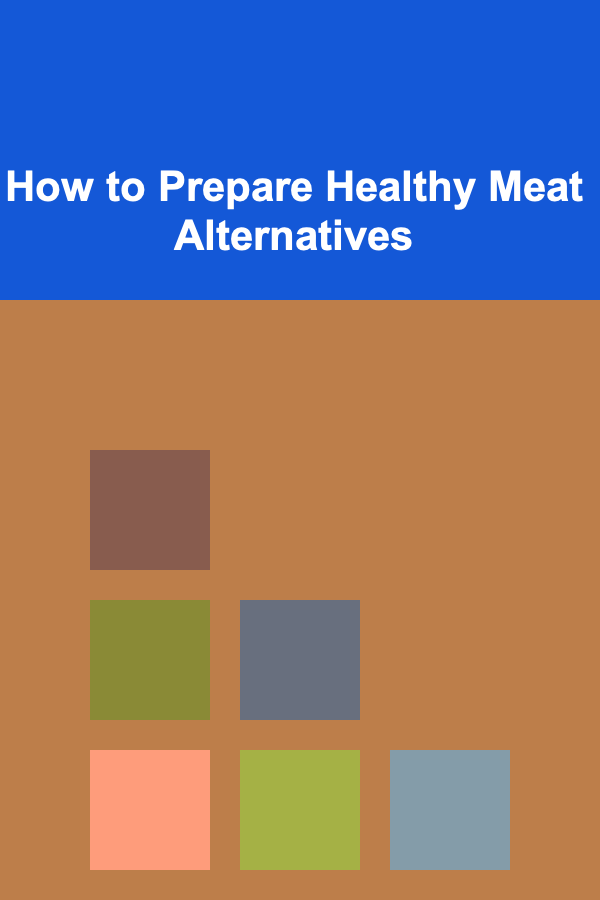
How to Cook One-Pan Wonders for Easy Cleanup
ebook include PDF & Audio bundle (Micro Guide)
$12.99$6.99
Limited Time Offer! Order within the next:

Cooking is an art that involves creativity, patience, and, sometimes, a little bit of chaos. One of the most daunting parts of cooking can often be the cleanup afterward. Pots, pans, bowls, spoons, and measuring cups can accumulate in the sink, creating a mess that may discourage some people from cooking in the first place. However, there's a solution: One-pan cooking.
One-pan wonders not only make meal preparation easier, but they also minimize the number of dishes to wash afterward, making cleanup a breeze. This cooking method focuses on preparing entire meals in a single pan or dish, whether it's a sheet pan, skillet, or Dutch oven. The beauty of this style of cooking lies in its simplicity, the flexibility of ingredients, and the convenience it provides.
In this article, we will explore the concept of one-pan cooking, the benefits it offers, and how you can make the most of this technique in your kitchen. Whether you're a seasoned chef or a novice cook, one-pan wonders will simplify your cooking experience while yielding delicious and satisfying meals.
The Appeal of One-Pan Cooking
Before diving into the practical steps of creating one-pan wonders, it's important to understand why this method has gained popularity in recent years. There are several reasons why one-pan meals have become a go-to solution for many home cooks.
1. Simplified Cleanup
Arguably the most significant benefit of one-pan meals is the minimal cleanup. Instead of dealing with a kitchen full of dishes, utensils, and cooking tools, you'll only need to wash the pan or dish used to prepare the meal. This saves both time and energy, making it an ideal option for busy weeknights, after a long day at work, or when you simply don't want to spend too much time cleaning.
2. Ease of Preparation
One-pan cooking often involves throwing all the ingredients into a single vessel, seasoning, and then cooking it. It eliminates the need to juggle multiple pots, bowls, and utensils. For beginners, this simplicity can provide a confidence boost and encourage more frequent cooking.
3. Flavor Development
Cooking everything together in one pan allows the flavors to meld and develop, creating a harmonious dish. Ingredients like vegetables, proteins, and spices can cook together, absorbing one another's flavors and creating a more cohesive meal. The result is a dish that feels and tastes more integrated than meals prepared in separate pots and pans.
4. Versatility
One-pan cooking is incredibly versatile. You can adapt the ingredients based on what you have in your pantry or refrigerator. From hearty sheet-pan dinners to skillet meals, the possibilities are endless. Whether you prefer vegetarian meals, lean proteins, or rich, indulgent dishes, there's a one-pan recipe for every dietary preference.
5. Healthier Meals
By using a single pan, you can control the cooking process more effectively. You're less likely to overcook or burn ingredients, which helps retain nutrients. Additionally, many one-pan recipes feature balanced ingredients, such as lean proteins, vegetables, and whole grains, contributing to a healthier overall meal.
Types of One-Pan Meals
The beauty of one-pan cooking lies in the diversity of meals you can create. Depending on the pan or dish you choose, you can easily prepare breakfast, lunch, dinner, or even dessert using just one cooking vessel. Let's explore the different types of one-pan meals you can make.
1. Sheet-Pan Meals
Sheet-pan meals are among the most popular types of one-pan wonders. These meals typically involve spreading ingredients across a large baking sheet and roasting them together in the oven. The versatility of sheet-pan cooking allows for an infinite number of combinations, from roasted vegetables with chicken to salmon and asparagus.
Why choose sheet-pan meals?
- Easy to prepare and cook.
- Minimal hands-on time is required.
- Roasting enhances the flavors of the ingredients.
Example Recipe:
- Sheet-Pan Roasted Chicken with Vegetables
- Ingredients: Chicken thighs, baby potatoes, carrots, onions, garlic, olive oil, salt, pepper, rosemary.
- Instructions: Preheat the oven to 400°F. Arrange the chicken and vegetables on a sheet pan. Drizzle with olive oil, sprinkle with salt, pepper, and rosemary. Roast for 40--45 minutes, or until the chicken is cooked through and the vegetables are tender.
2. Skillet Meals
Skillet meals are another staple in the one-pan cooking world. They usually involve sautéing ingredients in a pan on the stovetop. Skillets are great for everything from stir-fries to pasta dishes to egg-based meals like frittatas. Cast-iron skillets are particularly popular because they retain heat well, ensuring even cooking.
Why choose skillet meals?
- Great for quick, high-heat cooking.
- Ideal for stir-fries, sautéing, and even baking.
- Works well for both breakfast and dinner.
Example Recipe:
- One-Pan Breakfast Skillet
- Ingredients: Eggs, potatoes, bell peppers, onions, spinach, cheese, salt, pepper.
- Instructions: Sauté diced potatoes, bell peppers, and onions in a skillet with olive oil until soft. Add spinach and cook until wilted. Crack eggs into the pan and cook to your desired doneness. Top with cheese, salt, and pepper.
3. Dutch Oven Meals
The Dutch oven is a versatile and durable cooking vessel that can be used for a variety of one-pan wonders. From slow-cooked stews to braised meats and casseroles, the Dutch oven's thick walls and lid allow for consistent cooking at both low and high temperatures.
Why choose Dutch oven meals?
- Perfect for slow-cooking, braising, and stewing.
- Retains moisture and enhances flavor.
- Can be used for both stovetop and oven cooking.
Example Recipe:
- Beef Stew in a Dutch Oven
- Ingredients: Chuck roast, carrots, potatoes, onions, garlic, beef broth, red wine, thyme, rosemary, bay leaves.
- Instructions: Brown the beef in the Dutch oven over medium heat. Add onions and garlic, cooking until fragrant. Add the carrots, potatoes, and herbs, followed by the beef broth and wine. Cover and simmer for 2--3 hours until the beef is tender and the flavors have melded.
4. Casseroles and Bakes
Casseroles are classic comfort food, and they are often prepared in a single baking dish. While traditional casseroles may involve multiple steps, one-pan casserole meals typically require minimal prep time and allow you to combine ingredients in a single dish for a hearty meal.
Why choose casseroles?
- Can be prepared ahead of time and baked when needed.
- A perfect solution for feeding a crowd.
- Great for using up leftovers.
Example Recipe:
- Cheesy Chicken and Rice Casserole
- Ingredients: Cooked chicken, rice, broccoli, cheese, cream of chicken soup, garlic powder, salt, pepper.
- Instructions: Preheat the oven to 350°F. Combine all the ingredients in a baking dish and mix well. Cover with foil and bake for 25--30 minutes. Uncover, top with additional cheese, and bake for another 10 minutes until the cheese is bubbly.
Tips for Making One-Pan Meals
1. Choose the Right Pan
Each type of one-pan meal requires a specific pan to achieve the best results. Consider the recipe you're making and select a pan that suits the cooking method. A large sheet pan is perfect for roasting, while a deep skillet or Dutch oven is ideal for sautéing and slow-cooking.
2. Layer Your Ingredients
For roasting or baking, it's often best to layer your ingredients in the pan. Place the proteins at the bottom and vegetables or starches on top to ensure that everything cooks evenly. For example, in a sheet-pan meal, the chicken or fish should go on the bottom to ensure they cook through while the vegetables roast on top.
3. Use High-Quality Ingredients
One-pan meals often require minimal seasoning or complex preparation, so the quality of your ingredients will really shine through. Fresh vegetables, high-quality proteins, and flavorful herbs and spices will elevate the dish.
4. Don't Overcrowd the Pan
When roasting or baking, be mindful not to overcrowd the pan. If the ingredients are too packed together, they will steam rather than roast, resulting in a less crispy and flavorful texture. Leave some space between ingredients to allow for better air circulation.
5. Embrace Leftovers
One-pan meals often work well with leftovers. You can repurpose last night's dinner by adding it to a new dish, reducing food waste, and saving time on meal prep.
Conclusion
One-pan wonders are an excellent solution for busy home cooks looking to streamline their cooking process while minimizing the cleanup. From sheet-pan meals to skillet stir-fries and hearty Dutch oven stews, there is no shortage of delicious and easy-to-make recipes that require just one pan. The simplicity and versatility of one-pan cooking allow you to experiment with different ingredients, flavors, and cooking methods, making it an exciting approach to home-cooked meals.
By embracing the art of one-pan cooking, you'll not only save time and effort but also create flavorful, satisfying dishes that the whole family will enjoy. Whether you're a novice in the kitchen or an experienced cook, one-pan meals are sure to become a staple in your cooking routine.

How to Educate Neighbors About Home Security Best Practices
Read More
How to Keep Your Pet's Accessories Neat and Tidy
Read More
How to Plan a Home Party on a Tight Budget
Read More
How to Give Feedback for Personal Growth
Read More
How to Prepare Healthy Meat Alternatives
Read More
10 Tips for a Weekly To-Do List That Reduces Stress
Read MoreOther Products

How to Educate Neighbors About Home Security Best Practices
Read More
How to Keep Your Pet's Accessories Neat and Tidy
Read More
How to Plan a Home Party on a Tight Budget
Read More
How to Give Feedback for Personal Growth
Read More
How to Prepare Healthy Meat Alternatives
Read More